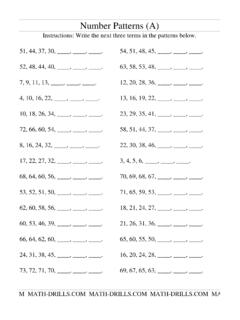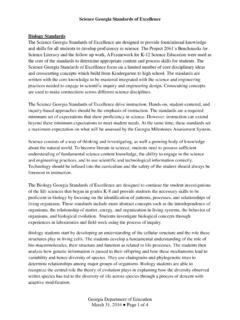Transcription of practice test The Biosphere Practice Test
1 Name: Practice test Score: 0 / 35 (0%) [12 subjective questions not graded] The Biosphere Practice Test Multiple Choice Identify the letter of the choice that best completes the statement or answers the question. 1. The branch of biology dealing with interactions among organisms and between organisms and their environment is called a. economy. c. recycling. b. modeling. d. ecology. ANSWER: D 2. The combined portions of Earth in which all living things exist is called the a. biome. c.
2 Ecosystem. b. community. d. Biosphere . ANSWER: D 3. All of the members of a particular species that live in one area are called a(an) a. biome. c. community. b. population. d. ecosystem. ANSWER: B 4. Which of the following descriptions about the organization of an ecosystem is correct? a. Communities make up species, which make up populations. b. Populations make up species, which make up communities. c. Species make up communities, which make up populations. d. Species make up populations, which make up communities.
3 ANSWER: D 5. The simplest grouping of more than one kind of organism in the Biosphere is a. a population. c. an ecosystem. b. a community. d. a species. ANSWER: B 6. The lowest level of environmental complexity that includes living and nonliving factors is the a. biome. c. ecosystem. b. community. d. Biosphere . ANSWER: C 7. Plants are a. producers. c. herbivores. b. consumers. d. omnivores. ANSWER: A 8. What is the original source of almost all the energy in most ecosystems?
4 A. carbohydrates c. water b. sunlight d. carbon ANSWER: B Figure 3 1 9. The algae at the beginning of the food chain in Figure 3 1 are a. consumers. c. producers. b. decomposers. d. heterotrophs. ANSWER: C 10. An organism that uses energy to produce its own food supply from inorganic compounds is called a(an) a. heterotroph. c. detritivore. b. consumer. d. autotroph. ANSWER: D 11. An organism that cannot make its own food is called a(an) a. heterotroph. c. autotroph.
5 B. chemotroph. d. producer. ANSWER: A 12. Organisms that obtain nutrients by breaking down dead and decaying plants and animals are called a. decomposers. c. autotrophs. b. omnivores. d. producers. ANSWER: A 13. What is an organism that feeds only on plants called? a. carnivore c. omnivore b. herbivore d. detritivore ANSWER: B 14. All the interconnected feeding relationships in an ecosystem make up a food a. interaction. c. network. b. chain. d. web. ANSWER: D 15.
6 The total amount of living tissue within a given trophic level is called the a. organic mass. c. energy mass. b. trophic mass. d. biomass. ANSWER: D 16. What is an ecological model of the relationships that form a network of complex interactions among organisms in a community from producers to decomposers? a. food web c. food chain b. an ecosystem d. a population ANSWER: A 17. What is the term for each step in the transfer of energy and matter within a food web? a. energy path c.
7 Trophic level b. food chain d. food pyramid ANSWER: C 18. A bird stalks, kills, and then eats an insect. Based on its behavior, which ecological terms describe the bird? a. herbivore, decomposer c. carnivore, consumer b. producer, heterotroph d. autotroph, herbivore ANSWER: C 19. A snake that eats a frog that has eaten an insect that fed on a plant is a a. first-level producer. c. second-level producer. b. first-level consumer. d. third-level consumer. ANSWER: D Figure 3 2 20.
8 The trophic levels in Figure 3 2 illustrate a. the relative amount of energy at each level. b. the amount of living organic matter at each level. c. the relative number of individual organisms at each level. d. that the producers outnumber first-level consumers. ANSWER: C 21. In which way does Figure 3 2 differ from a typical model of trophic levels? a. Second-level consumers outnumber first-level consumers. b. Third-level consumers outnumber second-level consumers. c. First-level consumers outnumber producers.
9 D. First-level consumers outnumber second-level consumers. d. First-level consumers outnumber second-level consumers. ANSWER: C 22. Only 10 percent of the energy stored in an organism can be passed on to the next trophic level. Of the remaining energy, some is used for the organism s life processes, and the rest is a. used in reproduction. c. stored as fat. b. stored as body tissue. d. eliminated as heat. ANSWER: D 23. Most of the energy available to a consumer trophic level is used by organisms for a.
10 Transfer to the next trophic level. b. respiration, movement, and reproduction. c. producing inorganic chemical compounds. d. performing photosynthesis. ANSWER: B 24. Which type of pyramid shows the amount of living tissue at each trophic level in an ecosystem? a. a numbers pyramid c. a biomass pyramid b. an energy pyramid d. a food pyramid ANSWER: C 25. Matter can recycle through the Biosphere because a. matter is passed out of the body as waste. b. matter is assembled into chemical compounds.










